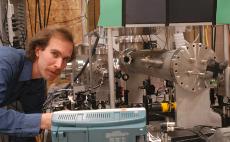UI scientists identify molecules present in birthplace of stars

Professor Ben McCall inspects the ion beam laser spectrometer that he and his team have spent the last two years building in Roger Adams Lab Wednesday. The spectrometer aids McCall in studying molecules that may be present in interstellar clouds. Suzanne Stelmasek The Daily Illini
Dec 8, 2006
Last updated on May 12, 2016 at 06:52 a.m.
Ben McCall and his group are researching the chemistry of interstellar clouds, clouds that exist between stars and often provide them with a birthplace.
McCall’s group uses a method called spectroscopy to study electromagnetic reactions in cloud particles. Spectroscopy is a technique that maps electromagnetic reactions and uses them to determine the identity of a molecule.
“Every molecule and atom has a different fingerprint, a different spectrum,” McCall said.
Fifty years ago, people did not think that were molecules in the clouds, McCall said, adding that there are over 100 different types of chemical compounds in these clouds. Before then, scientists were missing out on the “rich chemistry that’s going on,” he added.
Get The Daily Illini in your inbox!
“We are trying to figure out how they formed, and the (chemical) process that is going on inside of them,” McCall said.
These processes can create common Earth molecules, such as water. Scientists believe water forms in these clouds and that comets may have delivered water from such clouds to Earth, providing an environment conducive to life.
McCall uses spectroscopy to identify molecules, because the clouds are too far away to use other methods.
Part of the team’s research uses spectroscopy to find the spectra of molecular ions here on Earth so that they may be identified in space, he added. These ions are extremely reactive, and due to their sensitive nature, they cannot be studied in the average Earth lab.
It is because of their volatile nature that they are vital to interstellar clouds.
“In interstellar clouds, a lot of reactions need molecular ions, as they are very reactive,” he said.
All this scientific research exists at the nexus of astronomy and chemistry, in the discipline of astrochemistry.
“What needs to happen is the cross-fertilization of ideas,” he added.
McCall’s group consists of researchers, graduate students and undergraduates.
“I’m a big fan of undergrads getting into research,” McCall said.
Brett McGuire is one of those undergraduates. He is currently doing laser research concerning spectroscopy and Carbon 60.
The McCall group is currently trying to discover the behavior of a laser that is defying spectral expectations.
“We’re working backwards to figure out the variables,” he said.
Research done in the research lab is a very different experience compared to one in classes, said Bogdan Negru, a senior who works in the lab.
“I’ve learned more here in two weeks than in my physics class (all year)” McGuire said.





